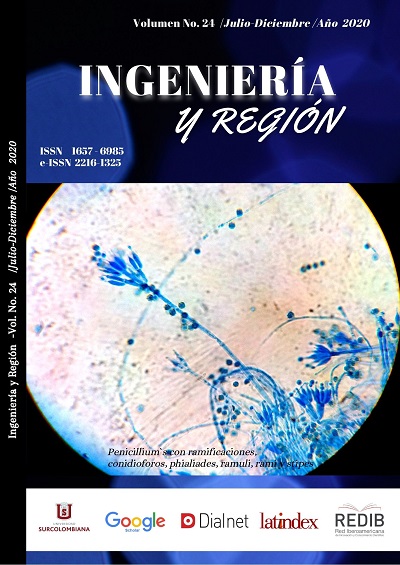Analysis of fractures and characterization of joints of the Villeta formation, western sector of the Neiva sub-basin
##plugins.themes.bootstrap3.article.main##
To evaluate naturally fractured reservoirs, there are different sources of information and methods that may be of limited access or high costs, especially for formations in which their level of productivity is unknown, or that have not yet been studied to determine their viability as hydrocarbon producer. Therefore, this article presents the application of an outcrop analysis method, as a source of indirect information, to characterize and determine the possible migration routes of the Hondita and Lomagorda carbonate formations belonging to the Villeta group. In the development of this characterization, the use of rectangular window-type fracture sampling strategies was implemented, through the exercise of taking structural measures, such as direction, dip, separation and spacing, over delimited areas in the outcrops of the formations of interest. With the help of the results, were identified 7 zones of joints, with a trend in low-angle courses with ranges in the northeast direction, establishing that this would be the predominance of fluid migration; giving an expectation that these data positively improve the development of the reservoirs.
Downloads
##plugins.themes.bootstrap3.article.details##
Agosta, F., Alessandroni, M., Antonellini, M., Tondi, E., Giorgioni, M., 2010. From fractures to flow: a field-based quantitative analysis of an outcropping carbonate reservoir. Tectonophysics 490, 197–213. https://doi.org/10.1016/j.tecto.2010.05.005
Aguilera, R., & Aguilera, M. S., 2001. Aspectos geológicos y de ingeniería en yacimientos naturalmente fracturados. Revista Fuentes, 1(1).
Barrios L. A., 2015. Caracterización geológica de los indicios superficiales de hidrocarburos en el departamento del Huila "zona centro-Caracterización Popayo”. Neiva: Universidad Surcolombiana.
Blanco, M., Macia, A., Sanabria., 2002. Geología estructural de piedemonte oriental de la cordillera central entre los municipios de Yaguará y Palermo, Valle Superior del Magdalena. Departamento del Huila (Colombia) / Mauricio Alberto Blanco; dirs. Carlos Macía, Mario de Freitas. Tesis de grado. pp 98.
Cockett R., 2011. https://app.visiblegeology.com/stereonet.html. Consultado el 11 de julio de 2020.
Curran J., 1999. Dips, (Versión 3.0). [Programa de computador]. Toronto, Ontario, Canadá: Rocscience Inc.
Duque, C. A., Gómez, R., Cabrejo, T., Fonseca, C., & Garcia, J., 2012. Potencial Adicional De La formación Tetuán En El Campo Tenay. In 11th Simposio Bolivariano-exploración Petrolera en las Cuencas Sub Andinas (pp. cp-330). European Association of Geoscientists & Engineers. https://doi.org/10.3997/2214-4609-pdb.330.88
Ferreira, P., Núñez, A., Rodríguez, M.A., 2002. Levantamiento geológico de la plancha 323, INGEOMINAS.
Fisher, N.I., 1995. Statistical Analysis of Circular Data. Cambridge University Press, pp. 277.
Gómez, E., Jordan, T. E., Allmendinger, R. W., Hegarty, K., y Kelley, S., 2005. Syntectonic Cenozoic sedimentation in the northern middle Magdalena Valley Basin of Colombia and implications for exhumation of the Northern Andes: Geological Society of America Bulletin, 17 (5-6): 547-569. https://doi.org/10.1130/B25454.1
Guerriero, V., Mazzoli, S., Iannace, A., Vitale, S., Carravetta, A., Strauss, C., 2013. A permeability model for naturally fractured carbonate reservoirs. Marine and Petroleum Geology. 40, 115–134. 10.1016/j.marpetgeo.2012.11.002
Khoshbakht, F., Azizzadeh, M., Memarian, H., Nourozi, G., Moallemi, S., 2012. Comparison of electrical image log with core in a fractured carbonate reservoir. J. Petrol. Sci. Eng. 86, 289–296. https://doi.org/10.1016/j.petrol.2012.03.007
Larssen, K., Senger, K., Grundvåg, S. A., 2020. Fracture characterization in Upper Permian carbonates in Spitsbergen: A workflow from digital outcrop to geo-model. Marine and Pettroleum Geology. 122. https://doi.org/10.1016/j.marpetgeo.2020.104703
Padilla, R., Toledo, R., 2013. Evaluación de yacimientos naturalmente fracturados y retos por resolver. Ingeniería petrolera, Vol. 53 No. 3, · ISSN 0185-3899.
Panza, E., Agosta, F., Zambrano, M., Tondi, E., Prosser, G., Giorgioni, M., Janiseck, J. M., 2015. Structural architecture and Discrete Fracture Network modelling of layered fractured carbonates (Altamura Fm., Italy). Ital. J. Geosci., Vol. 134, No. 3, pp. 409-422. https://doi.org/10.3301/IJG.2014.28
Priest, S.D., 1993. Discontinuity Analysis for Rock Engineering. Chapman & Hall, London, United Kingdom.
Roehl, P.O., Choquette, P.W., 2012. Carbonate Petroleum Reservoirs. Springer Science & Business Media. DOI: https://doi.org/10.1007/978-1-4612-5040-1
Spence, G. H., Couples, G. D., Bevan, T. G., Aguilera, R., Cosgrove, J. W., Daniel, J, M., and Redfern, J., 2014. Advances in the study of naturally fractured hydrocarbon reservoirs: a broad integrated interdisciplinary applied topic. Geological Society, London, Special Publications, 374, 1-22. https://doi.org/10.1144/SP374.19
Stephenson, B.J., Koopman, A., Hillgartner, H., McQuillan, H., Bourne, S., Noad, J.J., Rawnsley, K., 2007. Structural and stratigraphic controls on fold-related fracturing in the Zagros Mountains, Iran: implications for reservoir development. http://dx.doi.org/10.1144/GSL.SP.2007.270.01.01
Vo, M., Su, S., Lv, J., Xiao, C., 2020. Reservoir Modeling and Production History Matching in a Triassic Naturally Fractured Carbonate Reservoir in Sichuan, China. Improved Oil and Gas Recovery, vol 4. DOI: 10.14800/IOGR.1155
Watkins, H., Bond, C. E., Healy, D., and Butler, R.W.H., 2015. Appraisal of fracture sampling methods and new workflow to characterize heterogeneous fracture networks at outcrop. Journal of Structural Geology. 72, 67-82. https://doi.org/10.1016/j.jsg.2015.02.001


















